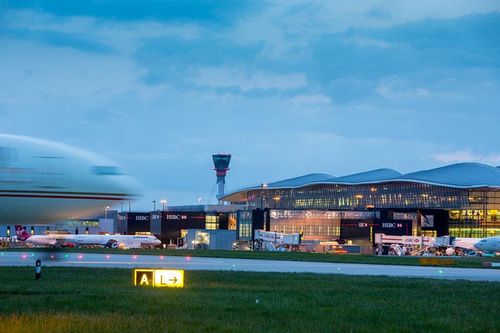Heathrow Airport targets 3% SAF use in 2025

SOURCE: Heathrow
January 17, 2025
BY Erin Voegele
London-based Heathrow Airport on Jan. 10 announced it targeting 5% sustainable aviation fuel (SAF) use in 2025. To support that goal, the airport is offering £86 million ($105.27 million) to airlines under its pioneering SAF incentive scheme.
Heathrow launched its SAF incentive scheme in 2022. In 2023, the program supported the use of approximately 70,000 metric tons of SAF, increasing to an estimated 155,000 metric tons in 2024.
The scheme aims to make SAF more affordable to airlines by creating a SAF incentive “pot” that is funded by aeronautical charges. According to Heathrow, airlines that plan to uplift SAF at the airport bid to the pot and receive a rebate.
The program is targeting 3% SAF use at Heathrow for 2025, equating to approximately 187,000 metric tons. The 2025 incentive aims to align with Heathrow’s target to be 1% above the U.K. mandate in 2030, achieving 11% SAF use at the airport.
Advertisement
“Sustainable Aviation Fuel is no longer a future promise—it’s a proven solution that is powering flights worldwide,” said Matt Gorman, director of carbon strategy at Heathrow. “Our SAF incentive scheme, part of our Connecting People and Planet sustainability strategy, has made significant progress and we're now exploring options to set a long-term incentive signal to 2030. We are delighted that government has moved so quickly to legislate the SAF Mandate. We must now accelerate legislation for the SAF Revenue Certainty Mechanism to ensure we can build a domestic industry that will help decarbonize and drive economic growth.”
The U.K.’s SAF mandate entered into force on Jan. 1, 2025. By law, SAF must now account for at least 2% of all jet fuel in flights taking off from the U.K. The mandate is set to expand to 10% in 2030 and 22% in 2040.
Advertisement
Related Stories
U.S. fuel ethanol capacity fell slightly in April, while biodiesel and renewable diesel capacity held steady, according to data released by the U.S. EIA on June 30. Feedstock consumption was down when compared to the previous month.
XCF Global Inc. on July 8 provided a production update on its flagship New Rise Reno facility, underscoring that the plant has successfully produced SAF, renewable diesel, and renewable naphtha during its initial ramp-up.
EcoCeres Inc. has signed a multi-year agreement to supply British Airways with sustainable aviation fuel (SAF). The fuel will be produced from 100% waste-based biomass feedstock, such as used cooking oil (UCO).
President Trump on July 4 signed the “One Big Beautiful Bill Act.” The legislation extends and updates the 45Z credit and revives a tax credit benefiting small biodiesel producers but repeals several other bioenergy-related tax incentives.
SAF Magazine and the Commercial Aviation Alternative Fuels Initiative announced the preliminary agenda for the North American SAF Conference and Expo, being held Sept. 22-24 at the Minneapolis Convention Center in Minneapolis, Minnesota.
Upcoming Events










